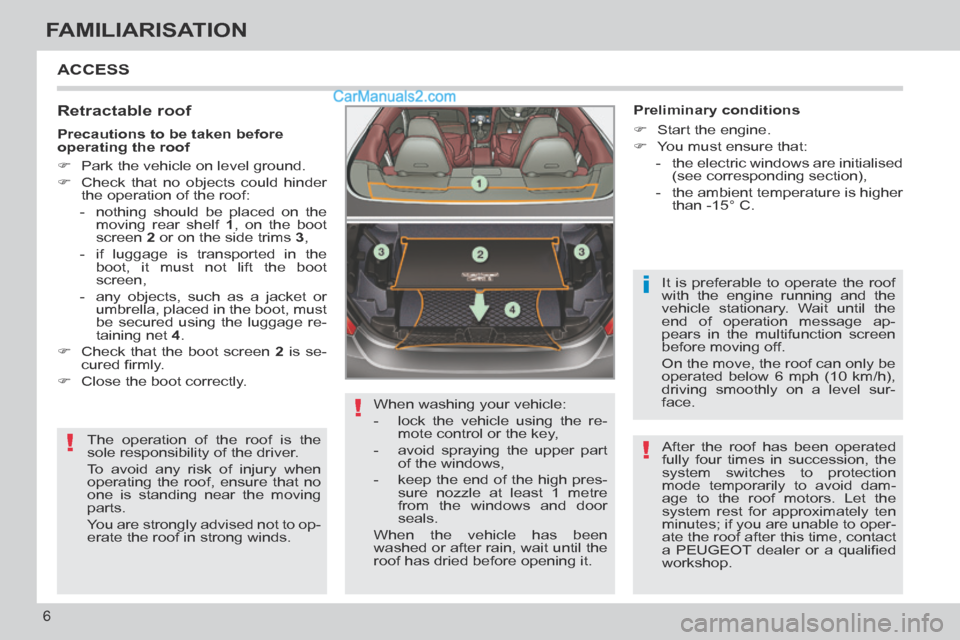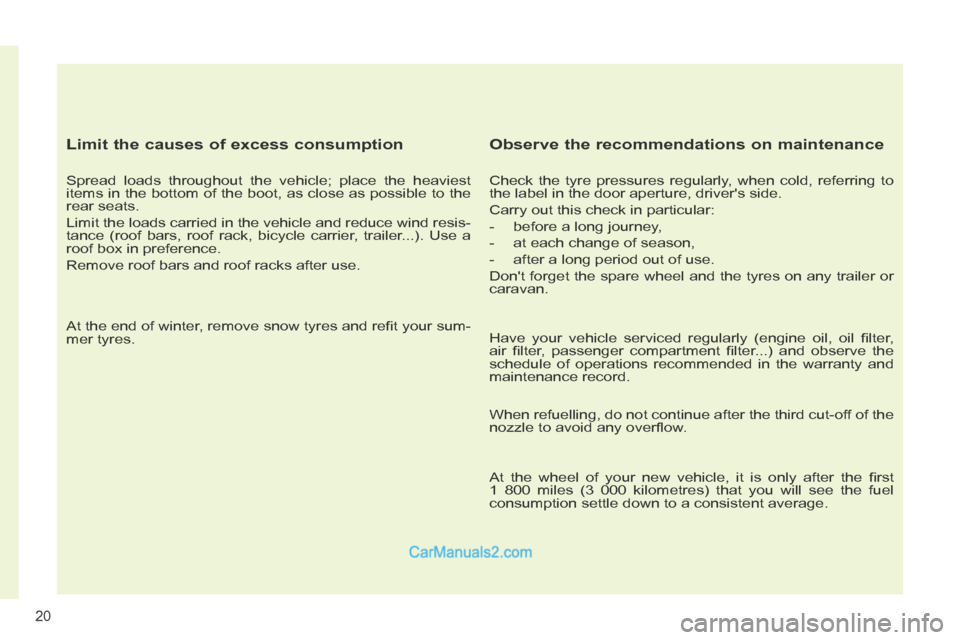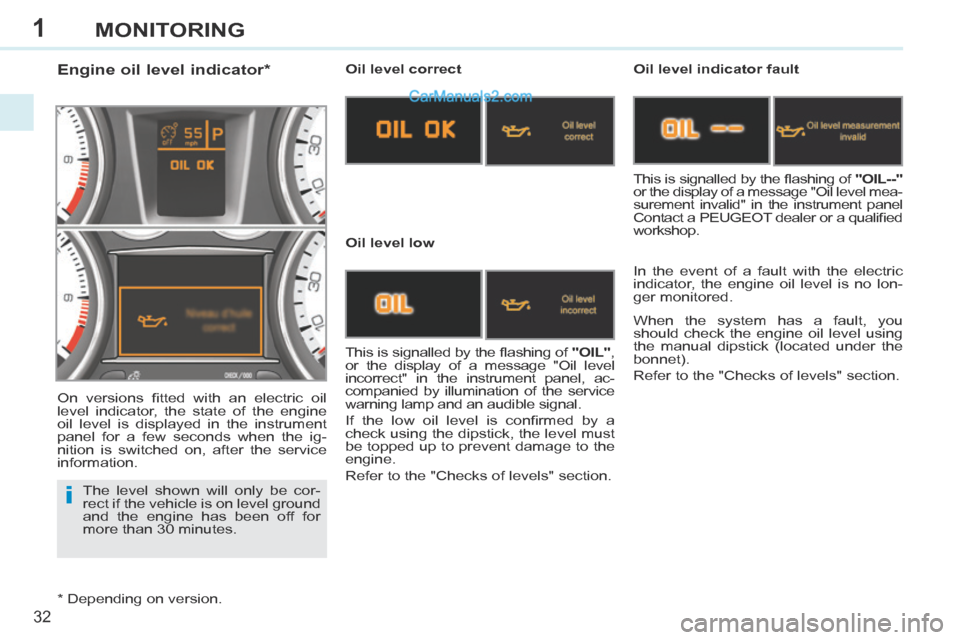2013.5 Peugeot 308 CC check engine
[x] Cancel search: check enginePage 5 of 268

3
CONTENTS
Direction indicators 93Hazard warning lamps 93Horn 93Emergency or assistance call 94Braking assistance systems 94Trajectory control systems 95Front seat belts 97Airbags 100Child seats 104Deactivating the passenger's front airbag 105ISOFIX child seats 110
SAFETY 93 11 3
Parking brake 114Manual gearbox 114Gear shift indicator 115Automatic gearbox 116Stop & Start 119Tyre under-infl ation detection 122Speed limiter 124Cruise control 126Parking sensors 128
DRIVING 114 129
Bonnet 131Running out of fuel (Diesel) 132Petrol engines 133Diesel engines 134Checking levels 135Checks 138
CHECKS 130 139
Temporary puncture repair kit 140Changing a wheel 145Snow chains 149Changing a bulb 150Changing a fuse 15512 V battery 161Energy economy mode 164Changing a wiper blade 165Towing the vehicle 165Towing a trailer 167Very cold climate screen 168Accessories 168
PRACTICAL INFORMATION 140 169
Petrol engines 170Weights (petrol) 171Diesel engines 172Weights (Diesel) 173Dimensions 174Identifi cation markings 175
TECHNICAL D ATA 170 D ATA 170 D ATA 176
AUDIO EQUIPMENT and TELEMATICS 177 251
VISUAL SEARCH 252 255
ALPHABETICAL INDEX 256 260
Emergency or assistance 177PEUGEOT Connect Navigation (RT6) 179PEUGEOT Connect Sound (RD5) 233
7
8
9
10
11
Page 8 of 268

!
!
i
!
6
FAMILIARISATION
ACCESS
Retractable roof
The operation of the roof is the
sole responsibility of the driver.
To avoid any risk of injury when
operating the roof, ensure that no
one is standing near the moving
parts.
You are strongly advised not to op-
erate the roof in strong winds. When washing your vehicle:
- lock the vehicle using the re-
mote control or the key,
- avoid spraying the upper part of the windows,
- keep the end of the high pres- sure nozzle at least 1 metre
from the windows and door
seals.
When the vehicle has been
washed or after rain, wait until the
roof has dried before opening it. It is preferable to operate the roof
with the engine running and the
vehicle stationary. Wait until the
end of operation message ap-
pears in the multifunction screen
before moving off.
On the move, the roof can only be
operated below 6 mph (10 km/h),
driving smoothly on a level sur-
face.
Preliminary conditions
Start the engine.
You must ensure that:
- the electric windows are initialised (see corresponding section),
- the ambient temperature is higher than -15° C.
Precautions to be taken before
operating the roof
Park the vehicle on level ground.
Check that no objects could hinder
the operation of the roof:
- nothing should be placed on the moving rear shelf 1 , on the boot
screen 2 or on the side trims 3 ,
- if luggage is transported in the boot, it must not lift the boot
screen,
- any objects, such as a jacket or umbrella, placed in the boot, must
be secured using the luggage re-
taining net 4 .
Check that the boot screen 2 is se-
cured fi rmly.
Close the boot correctly.
After the roof has been operated
fully four times in succession, the
system switches to protection
mode temporarily to avoid dam-
age to the roof motors. Let the
system rest for approximately ten
minutes; if you are unable to oper-
ate the roof after this time, contact
a PEUGEOT dealer or a qualifi ed
workshop.
Page 22 of 268

20
Limit the causes of excess consumption
Spread loads throughout the vehicle; place the heaviest
items in the bottom of the boot, as close as possible to the
rear seats.
Limit the loads carried in the vehicle and reduce wind resis-
tance (roof bars, roof rack, bicycle carrier, trailer...). Use a
roof box in preference.
Remove roof bars and roof racks after use.
At the end of winter, remove snow tyres and refi t your sum-
mer tyres.
Observe the recommendations on maintenance
Check the tyre pressures regularly, when cold, referring to
the label in the door aperture, driver's side.
Carry out this check in particular:
- before a long journey,
- at each change of season,
- after a long period out of use.
Don't forget the spare wheel and the tyres on any trailer or
caravan.
Have your vehicle serviced regularly (engine oil, oil fi lter,
air fi lter, passenger compartment fi lter...) and observe the
schedule of operations recommended in the warranty and
maintenance record.
When refuelling, do not continue after the third cut-off of the
nozzle to avoid any overfl ow.
At the wheel of your new vehicle, it is only after the fi rst
1 800 miles (3 000 kilometres) that you will see the fuel
c onsumption settle down to a consistent average.
Page 23 of 268

1
i
21
MONITORING
INSTRUMENT PANELS, PETROL OR DIESEL, MANUAL OR AUTOMATIC GEARBOX
5. Small screen.
6. Central screen.
7. Control button.
Starts a manual CHECK and recalls the service information.
Resets the function to zero (trip dis- tance recorder or service indicator).
8. Instrument panel lighting dimmer.
Adjusts the brightness of the lighting of the instruments and controls. Dials
1. Rev counter.
Indicates the speed of rotation of the engine (x 1000 rpm).
2. Coolant temperature.
Indicates the temperature of the en- gine coolant (°Celsius).
3. Fuel level.
Indicates the quantity of fuel remain- ing in the tank.
4. Vehicle speed.
Indicates the current speed of the moving vehicle (mph or km/h). A. Trip distance recorder.
(miles or km)
B. Distance recorder.
(miles or km)
C. Engine oil level indicator * ,
service indicator.
(miles or km)
These two functions are displayed when the ignition is switched on,
then disappear after a few seconds.
Displays
For more information, refer to the
section related to the button or
function and its associated display. The following functions are displayed in
accordance with the selection.
- Result of the CHECK.
- Alert messages symbol.
- Speed limiter / Cruise control.
- Gear shift indicator.
- Automatic gearbox.
- Trip computer.
* Depending on version.
Page 24 of 268

1
i
22
MONITORING
INSTRUMENT PANELS, PETROL OR DIESEL, MANUAL OR AUTOMATIC GEARBOX, WITH NAVIGATION
* Depending on version.
Dials
1. Rev counter.
Indicates the speed of rotation of the engine (x 1000 rpm).
2. Coolant temperature.
Indicates the temperature of the en- gine coolant (°Celsius).
3. Fuel level.
Indicates the quantity of fuel remain- ing in the tank.
4. Vehicle speed.
Indicates the current speed of the moving vehicle (mph or km/h). 5. Small screen.
6. Central screen.
7. Control button.
Starts a manual CHECK and recalls
the service information.
Resets the function to zero (trip dis- tance recorder or service indicator).
8. Instrument panel lighting dimmer.
Adjusts the brightness of the lighting of the instruments and controls.
For more information, refer to the
section related to the button or
function and its associated display. Displays
A. Trip distance recorder.
(miles or km)
B. Distance recorder.
(miles or km)
C. Engine oil level indicator * ,
service indicator.
(miles or km)
These two functions are displayed when the ignition is switched on,
then disappear after a few seconds.
The following functions are displayed in
accordance with the selection.
- Result of the CHECK.
- Alert messages.
- Speed limiter / Cruise control.
- Gear shift indicator.
- Automatic gearbox.
-
Navigation - Guidance / Trip computer.
- Repeat of the current speed.
Page 26 of 268

1
24
MONITORING
Warning lamp is on Cause Action/Observations
STOP fi xed, alone
or associated with another
warning lamp, accompanied
by an audible signal and a
message in the screen. Illumination of this warning
lamp is associated with
a serious fault with the
braking system, power
steering, engine lubrication
system or cooling system.
Stop as soon as it is safe to do so as there is a
risk that the engine will cut out while driving.
Park, switch off the ignition and contact a
PEUGEOT dealer or a qualifi ed workshop.
Braking fi xed,
associated
with the STOP warning lamp. The braking system fl uid
level is too low. You must stop as soon as it is safe to do so.
Top up with brake fl uid recommended by
PEUGEOT.
If the problem persists, have the system checked
by a PEUGEOT dealer or a qualifi ed workshop.
+
fi xed, associated with the STOP and ABS
warning lamp. The electronic brake force
distribution (EBFD) system
has a fault. You must stop as soon as it is safe to do so.
Have it checked by a PEUGEOT dealer or a
qualifi ed workshop.
Maximum
coolant
temperature fi xed with the
needle in the red zone. The temperature of the
cooling system is too high. Stop as soon as it is safe to do so.
Wait until the engine has cooled down before
topping up the level, if necessary.
If the problem persists, contact a PEUGEOT
dealer or a qualifi ed workshop.
Seat belt not fastened /
unfastened fi xed, then
fl ashing in the passenger's
seat belt and front airbag
warning lamp display. The driver or front
passenger has not fastened
or has unfastened their seat
belt.
Pull on the belt in question and insert the tongue
in the buckle.
For more information, refer to the "Seat belts"
section.
At least one rear passenger
has unfastened their seat
belt.
Page 27 of 268

1
25
MONITORING
Service temporarily,
accompanied
by a message. Minor faults have occurred
for which there is no
specifi c warning lamp. Identify the fault by reading the message
displayed in the screen, such as, for example:
- doors, boot or bonnet open,
- low engine oil level,
- low screenwash/headlamp wash reservoir
level,
- remote control battery fl at,
- a fault with tyre under-infl ation detection,
- saturation of the particle emission fi lter (Diesel) (see the "Checks" - "Checking
levels / Particle emissions fi lter" section).
For any other faults, contact a PEUGEOT dealer
or a qualifi ed workshop.
fi xed,
accompanied
by a message
and an audible signal. Major faults have occurred
for which there is no
specifi c warning lamp.
Identify the fault by reading the message shown
in the screen and
you must then contact a
PEUGEOT dealer or a qualifi ed workshop.
Warning lamp
is on Cause Action/Observations
Engine
autodiagnosis system fl ashing.
The engine management
system has a fault. Risk of destruction of the catalytic converter.
Have it checked by a PEUGEOT dealer or a
qualifi ed workshop.
fi xed. The emission control
system has a fault. The warning lamp should go off when the engine
is started.
If it does not go off, contact a PEUGEOT dealer
or qualifi ed workshop without delay.
Directional
headlamps fl ashing. The directional headlamps
system has a fault. Have it checked by a PEUGEOT dealer or a
qualifi ed workshop.
Page 34 of 268

1
i
32
MONITORING
The level shown will only be cor-
rect if the vehicle is on level ground
and the engine has been off for
more than 30 minutes.
Engine oil level indicator * Oil level correct
Oil level low Oil level indicator fault
In the event of a fault with the electric
indicator, the engine oil level is no lon-
ger monitored.
This is signalled by the fl ashing of "OIL" ,
or the display of a message "Oil level
incorrect" in the instrument panel, ac-
companied by illumination of the service
warning lamp and an audible signal.
If the low oil level is confi rmed by a
check using the dipstick, the level must
be topped up to prevent damage to the
engine.
Refer to the "Checks of levels" section. This is signalled by the fl ashing of
"OIL--"
or the display of a message "Oil level mea-
surement invalid" in the instrument panel
Contact a PEUGEOT dealer or a qualifi ed
workshop.
When the system has a fault, you
should check the engine oil level using
the manual dipstick (located under the
bonnet).
Refer to the "Checks of levels" section.
On versions fi tted with an electric oil
level indicator, the state of the engine
oil level is displayed in the instrument
panel for a few seconds when the ig-
nition is switched on, after the service
information.
* Depending on version.